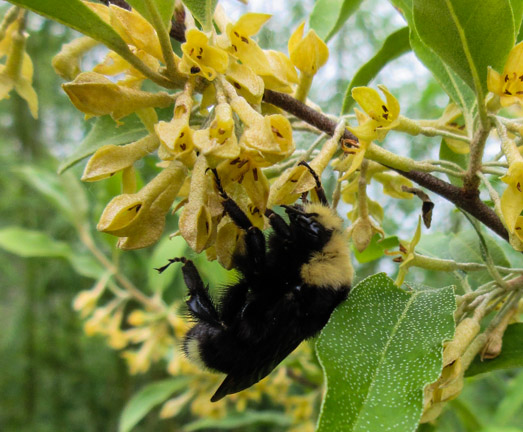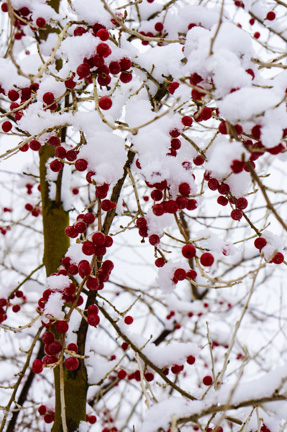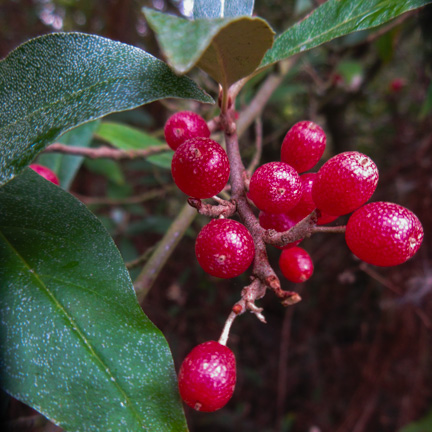Autumn Olive (Elaeagnus umbellata): its red speckled fruits stand out like tiny Christmas lights against the bare branches, so bright beneath the snow – such a gift in mid-December!

It was quite the revelation the other day when I went out to see whether there were any left (and yes! One shrub still had lots!) Not only are they much much sweeter in December, but they are so much easier to pick now that all the leaves have fallen off! You just slide your hands over the branches and they tumble into a small bowl held beneath – and when that is full, you dump it into a larger bowl and then go for another one.
Berry Abundant

It is interesting. I have 5 of these shrubs in my garden. I used to harvest them relatively early because the birds would always get them if I didn’t. One day, the shrub would be dotted with clusters of red fruits. The next day, not a single one. The efficiency of the birds can be quite amazing, so I learned that if I wanted some, I had to anticipate when they were going to harvest and then get there before they did. Of course, at the first sign of bird harvesting, I know the berries are ready, if not a little underripe. The astringency of an underripe berry can redefine what it means to pucker up. Birds don’t seem to mind.
This year, however, they cleaned off all the shrubs except one. They seemed to have left it purposely for me. I thanked them. I harvested what I could use (plus some extras for friends) and left plenty behind for them when they come back. There are colder, leaner days ahead, and I am sure my feathered friends will appreciate a winter treat, just as I have.
A Multipurpose Plant

The Autumn Olive is an amazing plant. The bees absolutely love the berries. The shrubs grow quickly, are a non-leguminous nitrogen fixer, provide food and habitat, and are useful in holding down eroding soil. The berries have 17 times higher levels of lycopene than do tomatoes; they are also a good source of omega 3s, antioxidants, and many vitamins and minerals. Unfortunately, in some areas of the U.S., they can be too much of a good thing. They have been used in restoration efforts and, thanks to the birds, have taken off, crowding out native species.
Here in the PNW, though, they are rarely found, and I have encountered very few individuals who are familiar with them. It’s like an awakening – “Wow! What IS this??!!”
I love to nibble the berries directly off the shrub, as would a deer. The berries are so much sweeter that way! Plus, they keep really well, even if you don’t get around to processing them right away. If a bowl of them is on the table, it’s easy to toss a few on oatmeal, over a salad, or into a smoothie.
The Autumn Olive Harvest is Such a Gift
It was a typical northwest day in mid-December that started out relatively calm but rose to an angry windy crescendo that swooped in from Canada and slammed us from the westerly coast. The rain stabbing sideways is always a sure sign. But I wasn’t ready to give up my outdoor chores just yet. I have been frantically trying to get the leaves raked up and piled on beds and around trees. It has been difficult to find time to get things done amidst the chaos of Christmas and being once again deluded into thinking I can make everyone meaningful gifts. Which, in thinking about jams, syrups, and elixirs, I realized I still hadn’t gotten around to picking all the autumn berries.
Agggh! One more thing to do! But I didn’t want them to go to waste! Surely, there couldn’t be that many left… I went out to the field to check, and lo and behold! There were tons! In mid-December! I kid you not!
“Thank you, birds, for leaving me some, and I shall do the same for you,” I said, and I went about rubbing the tiny stems off the branches and watching the berries tumble into my bowl.
The wind was gusting a good 30+ mph by now, and the rain was coming down in sheets and seemed to be getting worse. But I was determined. It was now or never. Shouting to the sky, I yelled out, “I am ready for you, Winter!” Such defiance, I admit, is dangerous. But there are times we need to embrace the cold that makes everything else warm; embrace the wind that screams at us to hunker down, because there is worse to come. I frequently talk to my garden, the sky, the wind, and to no one in particular except my very wet dog, who, being an intelligent and also a very loyal species, often wonders what the heck I am doing but vows to stay beside me no matter what.
I picked and picked and picked. Wonderful! These winter gifts! Amazing! And then, after awhile, thoroughly wet and the back of my neck stinging cold, I couldn’t help but softly say, “Well, this kinda sucks,” and so I went inside, but not without a very large bowl full of sunshine. And there were still plenty left for others. Such abundance! I truly love this shrub.
What did I learn from this?
- Autumn Olive berries are sweeter after a frost.
- The berries can be a bit fiddly to pick, but it is much easier after the leaves have fallen off.
- You can’t always wait for a nice day.

I am still left to wonder: why did this particular shrub still have so many berries, while on the others, not a single one? Is it a different species of Elaeagnus? Were the berries on this particular shrub not as good? To me, they taste great! No complaints!
I did not harvest them all. Some critter is going to be hungry on a cold December or January day and think, “Eureka! What a treat!” And maybe they might live a little longer to tell someone else about it.
We all work together.
* Thank you bees, for giving me all these berries.
* Thank you, birds, for eating the insect pests, fertilizing my garden, and eating your fill but also leaving me plenty of berries.
* Thank you, Elaeagnus umbellata, for fertilizing the soil, and for providing shade and shelter and life-saving sustenance to creatures of the fields and to my family and friends.
How to Use Autumn Olive Berries
-

So very many things we can do with these autumn olive berries! Fresh – great in salads (anything that uses cranberries can use autumn berries), on top of oatmeal with bananas and walnuts, any place you want a little “zing.” Autumn Olive berries are anti-inflammatory. Does anyone know how they compare with turmeric? I eat them by the handfuls. So many antioxidants! I feel brighter already!
- In baking: put some in pancakes. Great in breads.
- Dried whole – to me, not quite as good. I expected them to be like currants, but they were a bit dry and hard. Perhaps I over-dried them. Still, they were good thrown into a muffin batter. Nice little nibblers, if not a bit seedy.
- Fruit leather – the seeds provide a lot of texture, but leather is a concentrated goodness in a portable snack. In drying the pulp, spread it out on silicone sheets, not waxed or parchment paper, which tend to stick to the berries. Yes, you could filter out the seeds with a food mill, but then you would miss out on the Omega 3s, fiber, and other nutrients. I left them in.
- Jam – sweet spreads with a nutritive punch – these are great, but with the understanding that cooking destroys some of the nutrients. I try to minimize the high heat.
- In vinegars – yes! Try with a little basil! Vinegars act as a solvent that extracts nutrients and makes them more available. Try combining with some honey and – voila – you have a sipping vinegar that can be added to plain water or soda to make your own flavored waters.
- In teas: Autumn Olive berries added with Doug fir needles and rosemary, steeped in hot water, make a wonderful woodsy tea. The berries add almost an hibiscus zinger. I wonder what Autumn Olive berries with hibiscus would be like? Great idea to try!
- Smoothies. Most definitely. Your daily dose of lycopene in a glass. Counterbalances the over-sweetness of bananas. Combine in a nut milk. Yes. That will get you going.
- As an elixir, mixed with Aronia berries, for a winter tonic to combat colds and flu. Possibly better than elderberries? Who knows? Again, more research needs to be done.
- Gummy Bears: This was my latest “Eureka!” moment. I added gelatin to an autumn olive-aronia berry syrup and poured into molds. A great way to keep the sniffles away and a healthy preventative snack for the grandkids.
- Wines – oh my! This is turning out to be quite flavorful! Add equal parts sugar and water, mash them up, and let it sit until it bubbles. What is the effect of natural fermenting on nutrients? I would like to learn more, keeping in mind, all things in moderation. Hic. For medicinal purposes, however, quite acceptable.
Growing Conditions for Autumn Olive

There is a lot of information on the web about these amazing plants, so I don’t want to duplicate that here. Perhaps you live in an area where you can just go out and forage them in the wild. If you live in an area where they are not invasive, they can be a huge asset in the garden if you have room for them. The E. umbellata grows from 8- to 10-feet wide and tall (I have heard that other species can grow much larger), and it thrives best in zones 5-10. It likes sunshine and slightly acidic to neutral soil, and tolerates poor soil (even clay), drought, wind, and maritime climates, which pretty much defines our back field.
For the most part, this rugged shrub will grow just about anywhere, which is partly why in some areas, it can be a problem. One of ours, however, really struggled at one point. Half of it seemed to be dying. I suspected vole damage, which was confirmed when I dug down through the mulch around the base of the plant and found a massive tunnel network system. I stomped it all down, cleared out the weeds to increase air circulation and to make it more open so there would be less room to hide, and the critters moved out. The shrub fully recovered.
Anything around here that can survive vole attack, westerly gale-force winds, uneven watering, and lousy soil – plus deliver delightful fruits at the darkest time of the year – is to be admired.
I love this shrub. Did I say that already?
Perhaps there is an Autumn berry in your future?
~ * ~
May 3, 2019 Update:
Since the writing of this post, I have been doing additional research on the potential invasiveness of this plant and related species. As noted above, Elaeagnus can be a real problem in some areas, out-competing native plants and changing ecosystems and habitat. Please be sure to check with your local Noxious Weed Control Board to see whether it is invasive in your area.
~ * ~
For More Information –
Here are some links I found informative.
- The Nature Conservancy: “Journey with Nature: Autumn Olive” – This is an important article about just how invasive the Elaeagnus umbellata has become in some regions. Read this first before you plant! (Thank you, Dan, for sharing this link)
- “Autumn Olive and Russian Olive—What’s the Difference?” – an article by Techline Invasive Plant News that provides a map of where these two plants can be invasive across the country.
- The Druid’s Garden has a good post on Autumn Olives and a jelly recipe worth trying.
- One Acre Farm has great pictures and description, plus links to recipes for jam and ice cream.
- Hort Science provides the hard data: Yep, they are good for you.
There are many more good articles & posts out there; let me know if you find a link worth sharing. Thanks!

Please see the link below. Here in the midwest, Autumn olive was widely promoted for conservation plantings. It has since gone rogue and choked out a lot of native plants. We are actually putting a lot of effort to try to keep it in check here in MI.
https://www.nature.org/en-us/about-us/where-we-work/united-states/indiana/stories-in-indiana/autumn-olive/
Thank you, Dan – Great link! I added it to the resource list above. It really emphasizes how difficult this plant can be to eradicate if it becomes a problem. I especially like how the article gave recommendations for different native plants that can be planted instead.
The related species, Russian Olive (aka oleaster, silverberry, Elaeagnus angustifolia) is also known to be invasive in some regions, especially along riparian areas. Here in WA State, the Russian variety is starting to become a problem in Eastern Washington.
Permaculture fans often get excited about plants that add nitrogen to the soil and that have multiple other uses, and your link is a good reminder to anyone interested in ecosystem gardening to make sure you aren’t destroying the ecosystem you are trying to enhance!